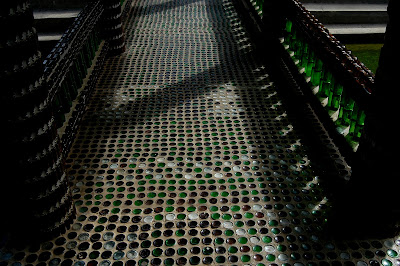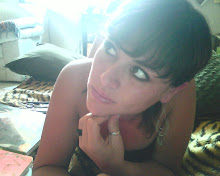 Postcard from Thailand (images: Juan Carlos)
Postcard from Thailand (images: Juan Carlos) Map of the trip (click to enlarge)
Map of the trip (click to enlarge)So we landed in Bangkok thinking to stay for two weeks, of which we had some days put aside to experience the capital, some others to go on vacation to Ko Samet and finally make an important trip to Wat Lan Koud, a temple built with glass bottles and that due to my interests in creative recycling, we both thought worth paying a visit.
The capital was a big surprise. A clean and quiet place -perhaps more so when one just arrives leaving behind the chaos of India-. The streets feel alive with people, everywhere shops abound, but mainly street stalls with exotic food. The urban setting is striking, especially in the complex structures that have been created for the movement of vehicles and people in the city. A subway system and an sky-train (as they call it), which at one point creates a super developed atmosphere, which gave the sensation -and vertigo- of being in a science fiction movie.
In an attempt to save some money, we ask for a place where to buy food to cook it at the guest house. A US guy recommended us Paragon City, a huge shopping center divided over seven floors, each with a specific sales section, in which can be found not only what you're looking for, but what you never expected to find. We were at the root of environmental problems – and thus social- of our times: consumerism. After talking, we both agreed that this was one of the most sophisticated shopping malls that we both had ever been, however, we realized this is only a tiny part of an economic system that is based precisely on that people consume a greater extent, which would be fine, as Juan Carlos says, if and only if, we would live on a planet with unlimited resources. But unfortunately that is not the case and those mirrors of reality leave us both with a dismal pessimism while watching from the second floor all those late model Japanese cars.

Thai Buddist Monk (images: Juan Carlos)
At the end of our visits to various temples and other tourist places that are in Bangkok, we are set towards the beach. The road was short and easy to reach. Juan Carlos had told me about this place. In his words, it was a quiet island with white sand, turquoise beaches, where you for very little money could rent a bungalow and eat seafood. My desire to reach that paradise was big, and while we were on the boat to the island, I was creating exotic expectations; but when we arrived Juan Carlos was deeply disappointed because as it was imagined, in twelve years the place had changed drastically, and it is now a resort that had already claimed the beaches and made them available to mostly European tourists. Finally we were already there and we should try to enjoy it, ignoring what bothered us. By doing so, before our eyes the scenery was quite beautiful, the sea, the sand and having time to enjoy a well deserved honeymoon in the midst of an already exciting journey together. What else could we ask life for? Yes, abusive and invasive tourism should disappear from the world, but, then again, what are we- even if we don´t like it- but part of those, whom are called tourists? Perhaps travelers who like Asian people say, "same same but not the same".

Baby on the beach (images: Juan Carlos)
After five days on the beach (stay more would put our budget in red), with a more relaxed pace and sun on our skins, we took a bus to Si Sa Ket, the city where we knew Wat Lan Koud, the bottles temple, was located. The road was not easy, partly because of our zero Thai and the limited English of the Thai people, but also by the rare transport system that one finds in the provinces of Thailand. Finally thanks to the willingness and support from the ever-smiling Thais, who between sign language and laughter made themselves to be understood, we reached the place.

Contrary to other experiences, our expectations of the temple were overcome by the size, beauty and especially for the opportunity to appreciate in front of us millions of glass bottles, of different shapes and sizes, adorning the walls of the temple. Floors, bridges, pillars, houses, baths, monk´s common living centers and even the water tank were all made under the same technique: bottles neatly encrusted with cement on the wall, fit together and alternating colors of the bottles and thus making shapes and patterns; and ontop of it all, murals and ornamentation formed with bottle caps. But undoubtedly the main temple is the one who gets the most applause, located on the center of a fish pond, with a classic Thai architectural style, walls over ten feet tall, and with ceilings that impress for the careful detail and accuracy with which the necks of the bottles end up with the exact touch of traditional roofs in temples in this country.
 Buddist Monk house (images: Juan Carlos)
Buddist Monk house (images: Juan Carlos)
I guess for anyone who does appreciate creativity this place is impressive, but to me that as an art director and as an environmentalist, this visit was very special because throughout my career I have discovered in creative recycling, a solution to one of the many problems that we humans are confronting: the problem of garbage. Now, in front of us was a Buddhist community who built a temple with bottles on every corner, a further proof that when one thinks to do something functional out of garbage, one can do things not only functional but aesthetically admirable.
Wat Lan Koud, was a visit that the two of us enjoyed a lot. That was not the case with the way to the Cambodian border, which at one time seemed impossible, and that after much questioning, many signs, many frustrations and much bargaining, we agree that the next day we would take a private van. It was the only way to reach the border, as already mentioned, development and modernity that is appreciated in Bangkok, is anything but a reality that in the provinces is founded, where there are hardly any buses linking the major cities.





No hay comentarios:
Publicar un comentario